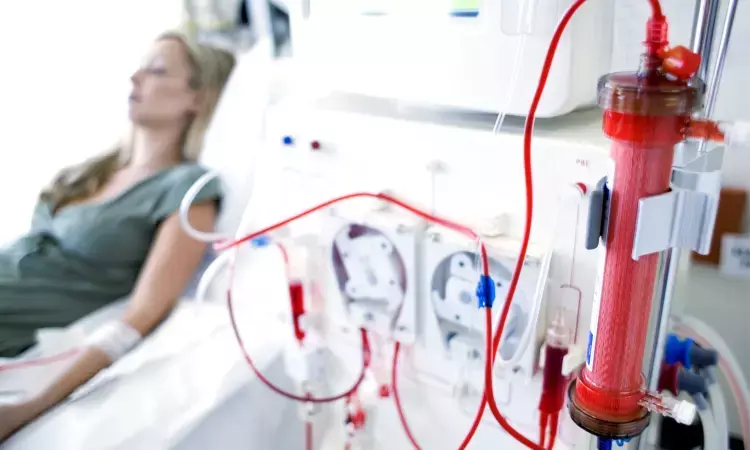- Home
- Medical news & Guidelines
- Anesthesiology
- Cardiology and CTVS
- Critical Care
- Dentistry
- Dermatology
- Diabetes and Endocrinology
- ENT
- Gastroenterology
- Medicine
- Nephrology
- Neurology
- Obstretics-Gynaecology
- Oncology
- Ophthalmology
- Orthopaedics
- Pediatrics-Neonatology
- Psychiatry
- Pulmonology
- Radiology
- Surgery
- Urology
- Laboratory Medicine
- Diet
- Nursing
- Paramedical
- Physiotherapy
- Health news
- Fact Check
- Bone Health Fact Check
- Brain Health Fact Check
- Cancer Related Fact Check
- Child Care Fact Check
- Dental and oral health fact check
- Diabetes and metabolic health fact check
- Diet and Nutrition Fact Check
- Eye and ENT Care Fact Check
- Fitness fact check
- Gut health fact check
- Heart health fact check
- Kidney health fact check
- Medical education fact check
- Men's health fact check
- Respiratory fact check
- Skin and hair care fact check
- Vaccine and Immunization fact check
- Women's health fact check
- AYUSH
- State News
- Andaman and Nicobar Islands
- Andhra Pradesh
- Arunachal Pradesh
- Assam
- Bihar
- Chandigarh
- Chattisgarh
- Dadra and Nagar Haveli
- Daman and Diu
- Delhi
- Goa
- Gujarat
- Haryana
- Himachal Pradesh
- Jammu & Kashmir
- Jharkhand
- Karnataka
- Kerala
- Ladakh
- Lakshadweep
- Madhya Pradesh
- Maharashtra
- Manipur
- Meghalaya
- Mizoram
- Nagaland
- Odisha
- Puducherry
- Punjab
- Rajasthan
- Sikkim
- Tamil Nadu
- Telangana
- Tripura
- Uttar Pradesh
- Uttrakhand
- West Bengal
- Medical Education
- Industry
Denosumab Linked to High Incidence of Severe Hypocalcemia in Female Dialysis Patients 65 and Above: JAMA

Osteoporosis, common in postmenopausal women, involves reduced bone density, fragile bones, and a higher fracture risk. Patients with advanced chronic kidney disease (CKD) have an elevated fracture risk. Dialysis-dependent older patients face a high risk of low bone mass due to primary osteoporosis, CKD–mineral and bone disorder (CKD-MBD), or both.
According to an Original Investigation published in JAMA, the use of Denosumab in elderly, female dialysis-dependent patients resulted in a statistically and clinically significant higher risk of severe hypocalcemia when compared to oral bisphosphonates.
Dialysis patients face high morbidity from fractures with limited evidence of optimal treatment. Chronic kidney disease-mineral and bone disorder is prevalent, complicating diagnosis and treatment of fragility.
The study examined the incidence and comparative risk of severe hypocalcemia with Denosumab compared with oral bisphosphonates among dialysis-dependent female patients aged 65 years or older treated for osteoporosis. Exposure included 60 mg of Denosumab or oral bisphosphonates. Severe hypoglycemia [total albumin-corrected serum calcium below 7.5 mg/dL (1.88 mmol/L)] and very severe hypocalcemia [serum calcium below 6.5 mg/dL [1.63 mmol/L]were assessed.
Key points from the study are:
· 607/1523 denosumab-treated patients and 23/1281 oral bisphosphonate–treated patients developed severe hypocalcemia.
· The 12-week weighted cumulative incidence of severe hypocalcemia was 41.1% with Denosumab vs 2.0% with oral bisphosphonates. The weighted risk difference was 39.1%, and the weighted risk ratio was 20.7.
· The 12-week weighted cumulative incidence of very severe hypocalcemia was also increased with Denosumab (10.9%) vs oral bisphosphonates (0.4%). The weighted risk difference was 10.5%, and the weighted risk ratio was 26.4.
Denosumab was found to significantly increase the incidence of severe and very severe hypocalcemia compared to oral bisphosphonates when used in female dialysis-dependent patients aged 65 or older. Due to the difficulty in diagnosing bone pathophysiology in this population and the high risk associated with Denosumab, careful patient selection and frequent monitoring are necessary before administering the drug.
Reference:
Bird ST et al. Severe Hypocalcemia With Denosumab Among Older Female Dialysis-Dependent Patients. JAMA. Published online January 19, 2024. doi:10.1001/jama.2023.28239
BDS, MDS in Periodontics and Implantology
Dr. Aditi Yadav is a BDS, MDS in Periodontics and Implantology. She has a clinical experience of 5 years as a laser dental surgeon. She also has a Diploma in clinical research and pharmacovigilance and is a Certified data scientist. She is currently working as a content developer in e-health services. Dr. Yadav has a keen interest in Medical Journalism and is actively involved in Medical Research writing.
Dr Kamal Kant Kohli-MBBS, DTCD- a chest specialist with more than 30 years of practice and a flair for writing clinical articles, Dr Kamal Kant Kohli joined Medical Dialogues as a Chief Editor of Medical News. Besides writing articles, as an editor, he proofreads and verifies all the medical content published on Medical Dialogues including those coming from journals, studies,medical conferences,guidelines etc. Email: drkohli@medicaldialogues.in. Contact no. 011-43720751


